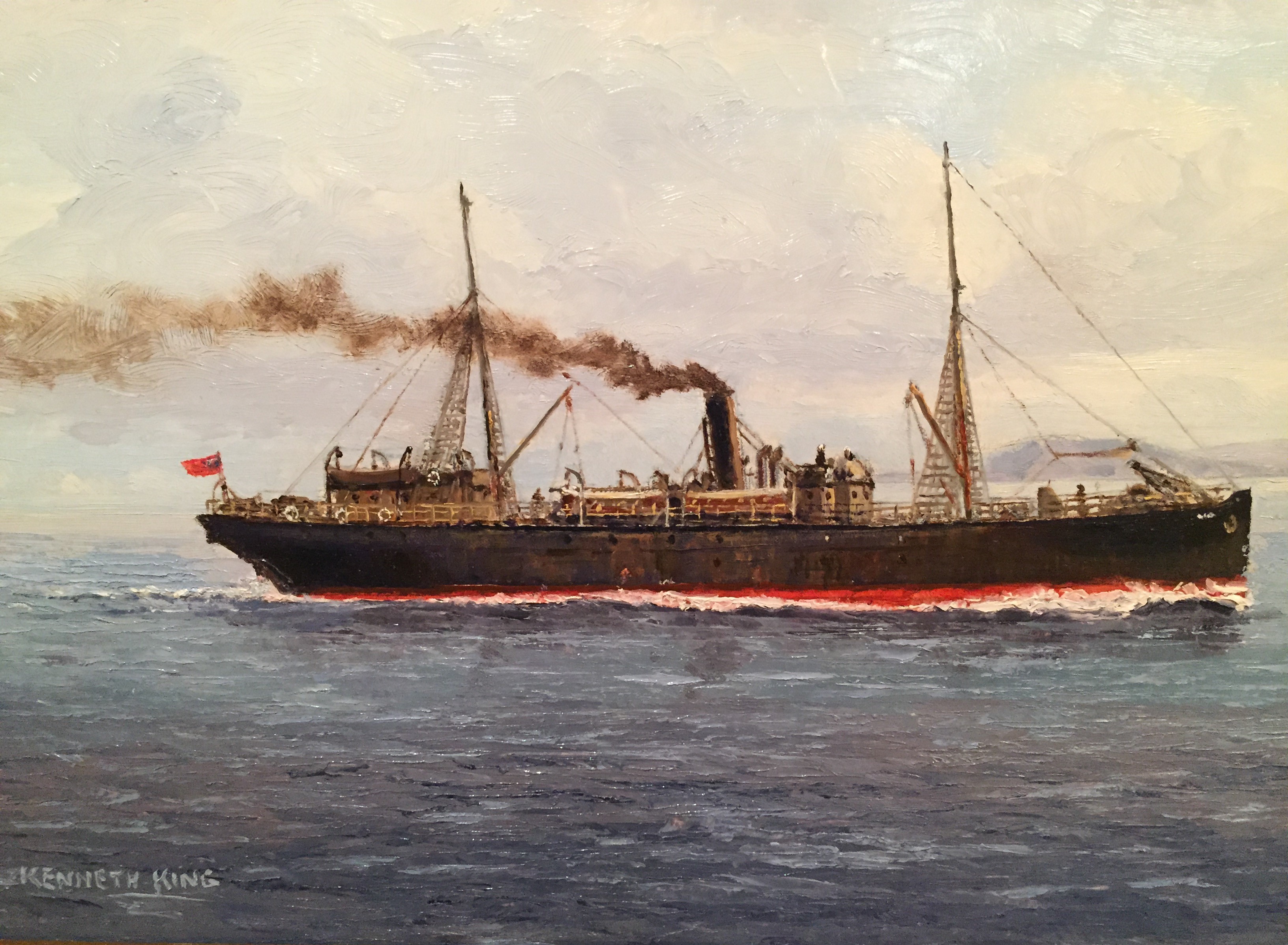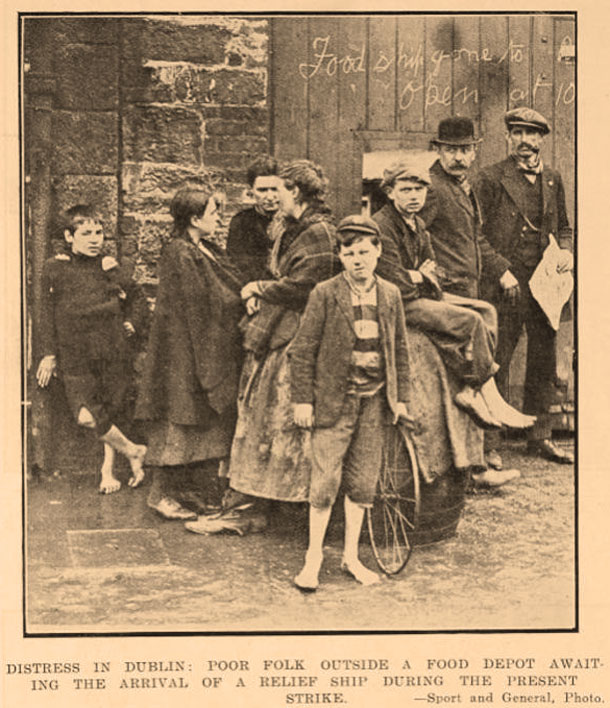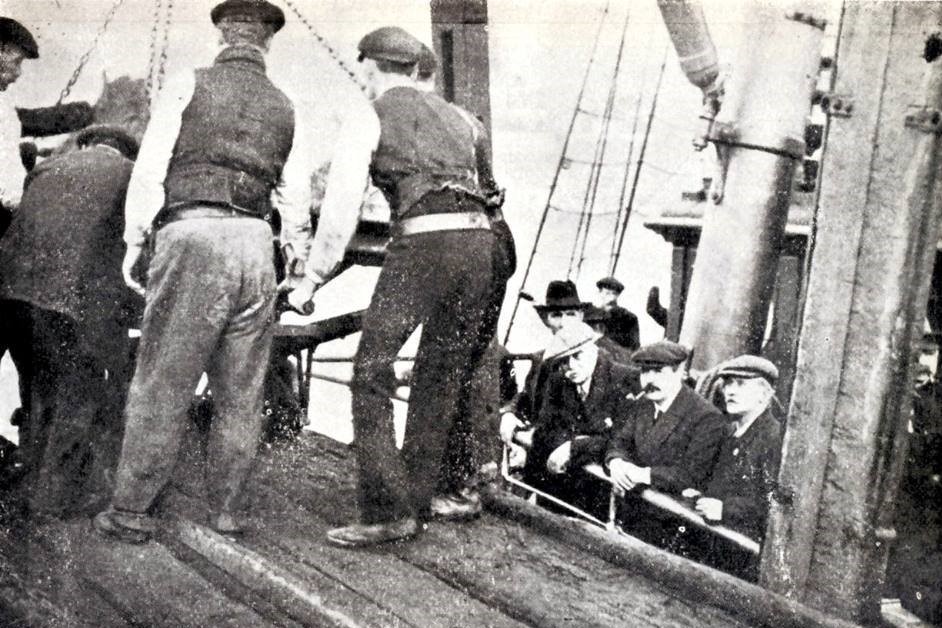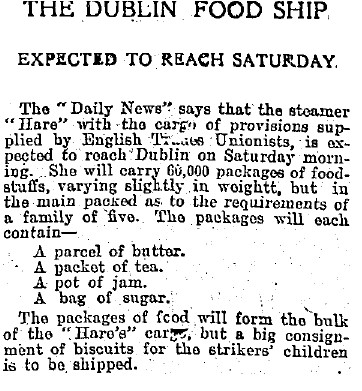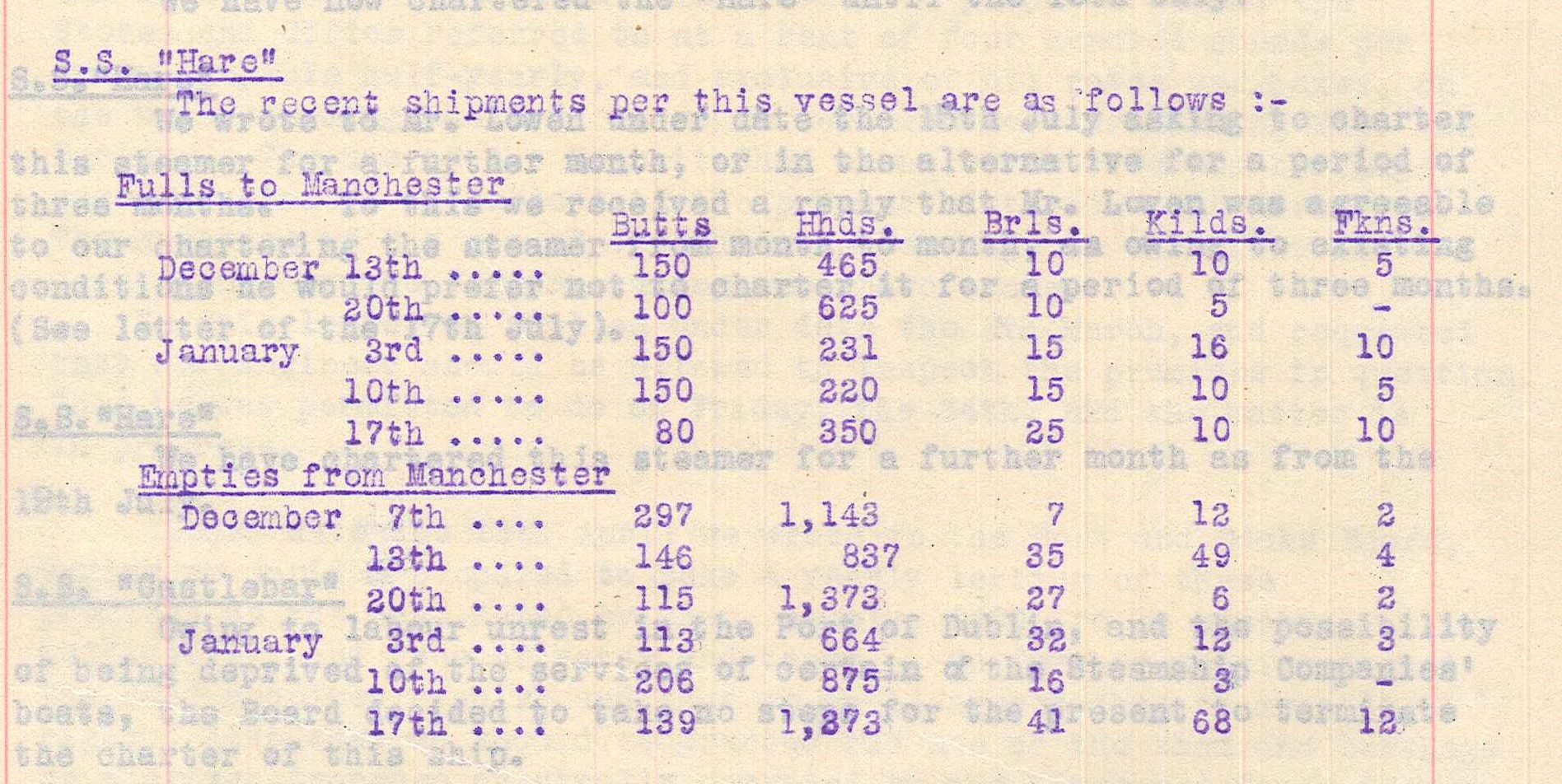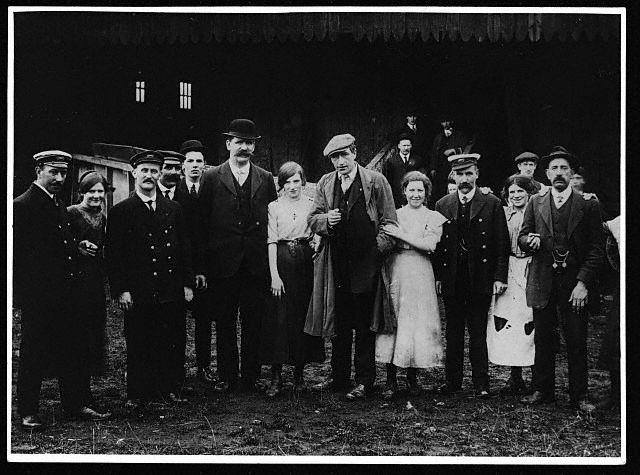The SS Hare was a steamship built in 1886 at Barclay Curle & Co. shipyard in Glasgow for G&J Burns Ltd. In 1899 ownership was transferred to George Lowen of Manchester. In partnership with Dublin business man D.J. Stewart, Lowen had established The Dublin & Manchester Steamship Company In 1897. Stewart was also the owner of the SS Duke of Leinster, from which vessel a number of the crew of the SS Hare transferred. This included Alexander Carmichael, 1st mate on the SS Duke of Leinster, who joined the SS Hare in February of 1900 and the following month became its Captain, a position he would still be holding on the ill fated voyage of 1917. For the years under his command, the SS Hare’s activity was recorded as ‘Trading between Dublin & Manchester carrying General Cargo, Livestock and Passengers”. On occasion trips to Liverpool were also undertaken.
It was during the industrial conflict of the Great Lockout in 1913 that the SS Hare came to fame among the Irish working class. James Larkin had founded the Irish Transport & General Workers Union (ITGWU) in 1909. He sought to unite Irish workers into one big union and used their numbers to force a radical change not just in the workplace but in society. The Dublin Docks were a prime recruiting ground, and labourers, carters, etc., flocked to its ranks. The ‘Larkinites’ won many key concessions and improvements in pay and conditions, the use of the sympathetic strike being a powerful tactic. Fearing the growth of organised labour, powerful businessman and newspaper owner William Martin Murphy, formed the Dublin Employers Federation. Workers were urged to sign a declaration disassociating themselves from the ITGWU. When many refused they were ‘locked out’ of their employment. The dispute escalated and soon 20,000 workers were involved, and in an already poverty stricken city this was catastrophic. Murphy believed that the workers could literally be starved into submission, informing the Dublin Chamber of Commerce:“The employer all the time managed to get his three meals a day, but the unfortunate workman and his family had no resources whatever except submission, and that was what occurred in 99 cases out of 100. The difficulty of teaching that lesson to the workmen was extraordinary.”
Larkin travelled to Britain to rally support, and the response from the workers there was phenomenal. The British Trade Union Congress (T.U.C.) raised funds to send essential supplies to their Dublin comrades, and an initial shipment of 60,000 food parcels was dispatched.The SS Hare was actually strike bound with a cargo of Guinness onboard, but agreement was reached to unload the cargo and she soon set off across the channel. The SS Hare sailed into Dublin on 27th September 1913 to scenes of jubilation. Paddy Buttner, a young boy at that time, was there to collect food for his family, his father being one of the strikers. He recalled the excitement –
“…a cheer rose from every throat of those watching when someone cried ‘It’s the SS Hare!’ The captain answered the swell of cheering with three sharp and one long blast on the siren , and it seemed to me , just a boy , to be saying – ‘It’s US, it’s US, it’s US ,HURRAY!’ The hair stood up on my head and I shouted with the rest in joy. As the vessel came abreast of the South Point, we all turned about and kept pace with her; the cheering and the waving continued while tears streamed down the faces of women and, indeed, men too. And all the while the crew and siren answered each cheer”.
This voyage of hope was only the first undertaken by the SS Hare, and she would be joined by the SS Pioneer and SS New Fraternity.The goods were stored in the Manchester Shed on Sir John Rogerson’s Quay throughout the Lockout. Thanks to the efforts of the T.U.C. by late November 255,330 packets of tea had been shipped to Dublin, 255,000 bags of sugar, 255,330 packets of margarine, 597,000 loaves of bread, 251,804 bags of potatoes, 1,856 lb of Jacob’s Biscuits, 72,639 pots of jam, 85,330 tins of fish, 12,500 boxes of cheese and almost 885 tons of coal. Food parcels were distributed right up until February of the following year when the strike was ended. This act of solidarity literally saved lives in Dublin, and has never been forgotten.
The 1913 log concludes “Ship lying in Dublin through Labour strike from Nov.12thuntil end of year”
The SS Hare would carry a variety of cargo in its lifetime, but it’s most famous customer was undoubtedly the Arthur Guinness, Son & Co. LTD. The iconic brewery would begin to develop their own legendary ‘Guinness fleet’ at the end of 1913, but the SS Hare would continue charters with the company until its loss. The regular routine would see barrels of stout being delivered to Manchester and the empty casks returned to Dublin.
As stated, the SS Hare was carrying a cargo for Guinness when it made its memorable Lockout mission. Communications from Guinness show that they expected nothing less than being accommodated-“I was fully aware of the circumstances under which she had been discharged”, but further added “under our agreement we were bound, while the boats were sailing, to give him our traffic and they were equally bound to take it.”
Throughout 1916 there was a series of agreements which essentially saw the SS Hare being on permanent contract during that historic year. Having enjoyed a series of weekly arrangements, inFebruary the Brewers accepted a “charter for one month for £1,000, we to supply coal and pay all dues, the other expenses payable to Mr.Lowen including full insurance of ship against war and maritime risks”.For the first half of April the Ship was in Dock for repairs but re-entered service just before the Easter Rising. Shipping from Dublin was curtailed during the rebellion, but on 3rd May the SS Hare arrived in Manchester with a cargo of Guinness, the first Dublin Port vessel to dock across the channel. There was a request from Guinness to charter on a three monthly basis but George Lowen was not agreeable. Lowen preferred a month-to-month arrangement, but eventually they settled on a two monthly arrangement.
Guinness of course had built up its own fleet by now. War time restrictions on brewing imposed by the Governmentled to a reduction in the demand for cross-channel cargos and the arrangements with Lowen concluded at the end of May. However, in June the Admiralty commandeered the SS Clarecastle and SS Clareisland from the Guinness fleet, forcing the Company to request the return of the SS Hare. They were informed that the vessel was not available due to other engagements.
During this period Guinness was experiencing real difficulties in shipping its product to a variety of destinations. They entered discussions with Tedcastle’s to arrange for 100 tons of stout to be carried to Liverpool on a weekly basis, though if this was to be on board the SS Adela is unclear.
On the 12th October 1917, the first of the Guinness fleet, the SS W.M. Barkley was torpedoed crossing the Irish channel. Almost exactly two months later when the SS Hare was lost in a similar attack at almost the same location. Of the 23 crew on board twelve would lose their lives while 11 would survive.
Following the sinking of the SS Hare, Guinness noted the loss as follows:
“This boat, which carried our beer for many years between Dublin and Manchester, and was frequently chartered by us, was torpedoed on Friday, the 14th, in the same locality as our own steamer the Barkley. She carried none of our property on this voyage. Eleven of her crew of twenty-two, including the Captain and the Chief Engineer, were saved”.
There is a final reference to the SS Hare recorded in Guinness reports, dated 25thJanuary 1918:“Lord Iveagh was reminded that we had written to Mr. Lowen telling him we were willing to assist in giving any financial assistance granted to the relatives of those who were lost in the HARE, but we’ve since heard from Mr. Lowen stating that he considered the public arrangements were ample to meet the necessities of the case, and that it was not proposed to take any steps in the matter.”
That was their last word on the relationship between the City’s most iconic product and one of the most famous vessels in the history of Dublin Port.
Eleven of those who were serving on the SS Hare in 1913 were aboard on the fateful voyage of December 1917. Daniel Eley, Donald Gilchrist, Lachlan MacFadyen, Joseph Edward Swords, Charles Walsh, James Wilson would lose their lives,while Alexander Carmichael, Thomas Brown, John Hunt, William McGowan and Christopher Tallant would survive.
This article appears in “Within the seat of war …Dublin Docklands and the sinking of the SS Hare and SS Adela 1917…” , published by The Adela-Hare Centenary Commemoration Committee , September 2017. Supported by Dublin City Council Decade of Commemoration Fund.
For further information , corrections , clarifications or to obtain the book contact adelahare1917@gmail.com
Image credits: ‘Guinness Archive, Diageo Ireland’
SS Hare painting by Kenneth King , courtesy of Eric Hopkins who commissioned the work.


